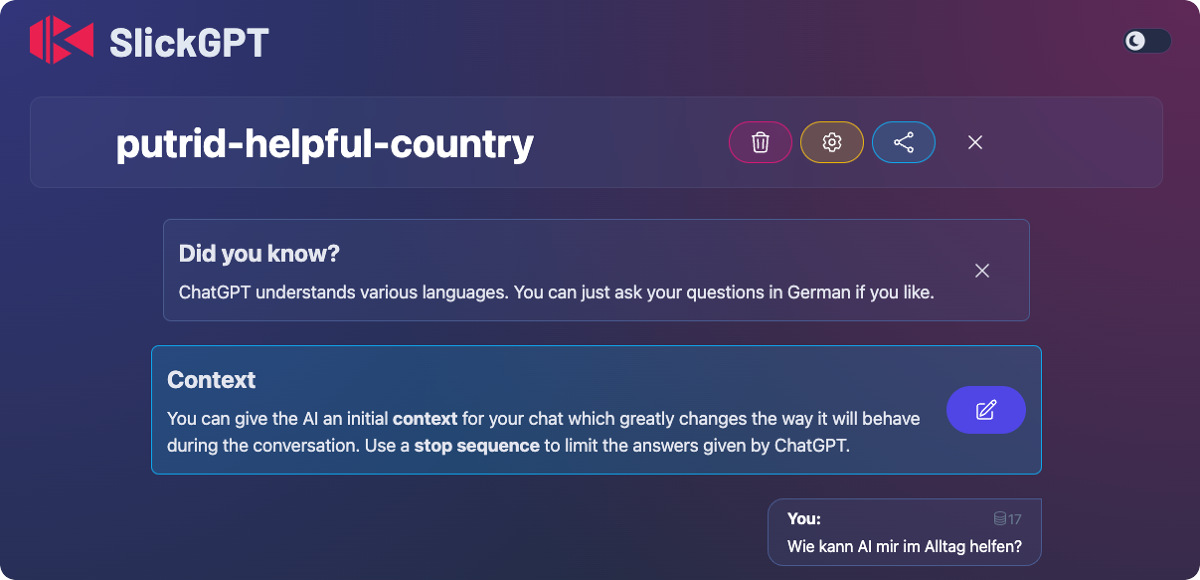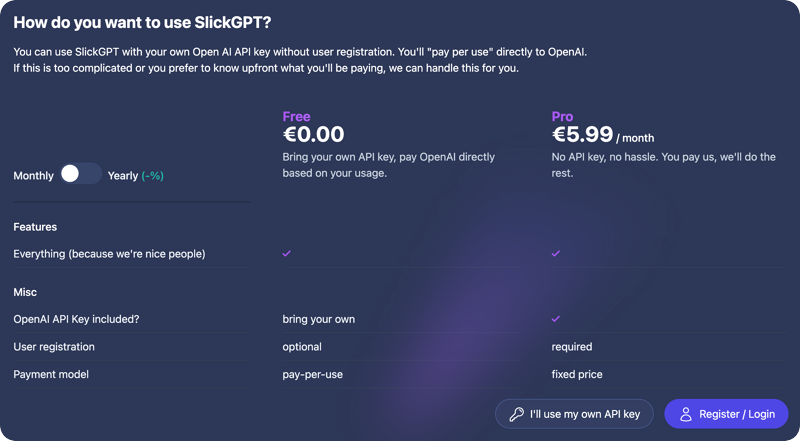SlickGPT

We love AI.
It’s 2023 and we’re already using Midjourney to create game assets and to inspire us. We utilize ChatGPT as peer programmer in code reviews and sometimes even to write simple or repetitive code in different languages. For some of us, it has even begun to replace Google as primary search engine.
So it’s no surprise that we want to get into programming as well. Started as a weekend hackathon, within a couple of days we developed a full-fledged ChatGPT client of our own, which we have been using on a daily basis ever since.
We wanted a fast, responsive (mobile-first) and effortless user experience. No authentication, as much work as possible done in the client browser to make it super fast. Basically, ChatGPT always at your fingertips.
Technically, it’s powered by one of our most beloved and established tech stacks:
- SvelteKit
- Tailwind
- Firebase
- Serverless (Edge) Functions
- hosted on Netlify or Vercel
We also used the project to evaluate Skeleton UI which is a Svelte/Tailwind-based UI framework that we immediately fell in love with and will be adding to our kit right away.
The secret sauce of ShipGPT is that almost everything is stored in the localStorage of the browser. One case where we step outside this boundary is, of course, when a user communicates with the OpenAI API. While questions are simple POST requests, responses are sent back to the client using the native EventSource API and rendered as a “live stream” just like the ChatGPT client does (when it’s not overloaded).
The other case is when users share their chats with others using our “userless share” feature. Then we dump the appropriate localStorage object in a simple Firebase Realtime Database and tag it with a random updateToken. Our serverless function sends this token back to the client where it is stored in the localStorage next to the original chat. It can be used later to update or unshare chats.
Update
You asked for it and we listened: Former ShipGPT is now Open Source and known as SlickGPT.
We started this as a weekend project and for our own use, but it quickly became more. We were honestly overwhelmed by the positive feedback and attention ShipGPT received from you in a very short time and without much advertising. Thank you!
We discussed monetization options, but decided on a different path: We want the client to remain accessible to everyone, to keep getting better and to be maintained by us and by the community. To make it financially feasible, we switched the open source variant to a “use your own API key” model.
We fixed a bunch of bugs (bye, bye huge input area after submit!), implemented new features like full GPT-4 support, token cost and much more and created a roadmap. We will continue to host a public version including the share feature, but if you’re interested, you can now also run your own instance.
Although we plan to keep the project going, for bigger features (like internationalization) we rely on your support - be it through contributions to our repository or through donations.
Update 2024
SlickGPT is still very popular and has a dedicated community of active users. To make the tool accessible to even more people, we now offer an optional paid “Pro” version that uses our own Azure cloud infrastructure to access the OpenAI services.
This way, our users can now use SlickGPT without having their own API key. The price is also “fixed” and not “pay-per-use” as with OpenAI. The Pro version currently has no additional paywall features and offers unlimited access to all supported OpenAI models.

AI power users can also subscribe to our “Wingman Ultra” package for unlimited use of both SlickGPT and Wingman AI.




